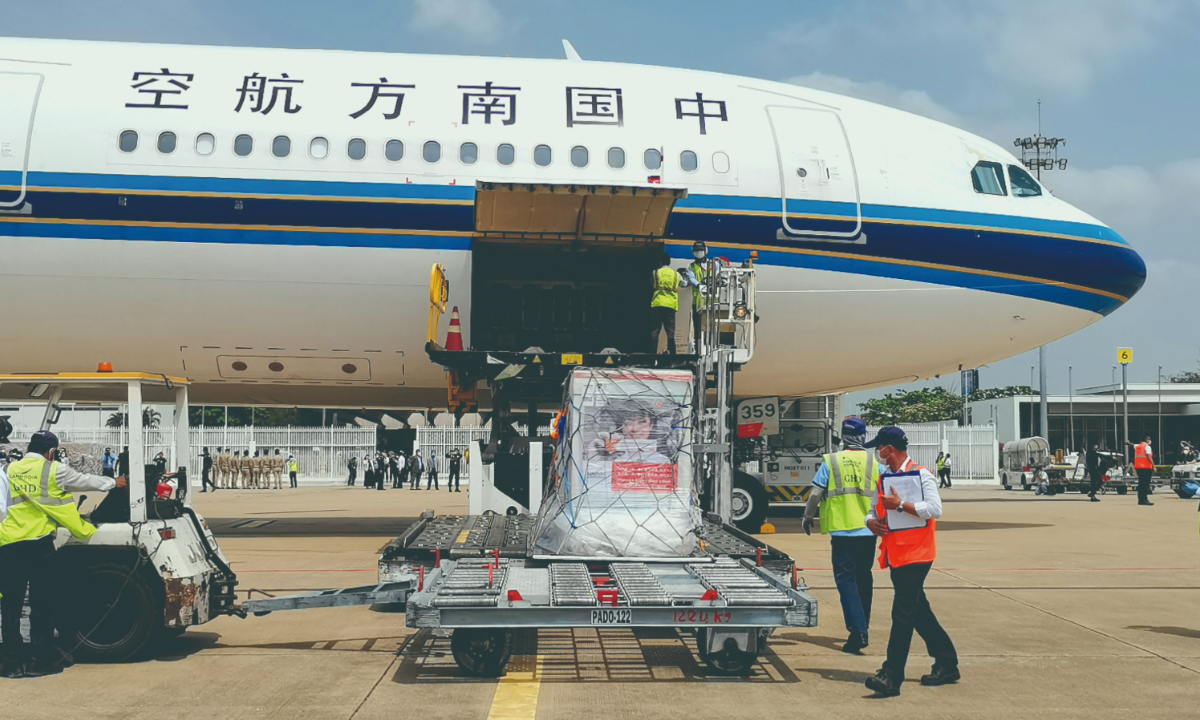China’s vaccine exports in lull, but experts forecast a rebound in 2022
Experts predict future demand to rise as new COVID variants emerge

The first shipment of 1.5 million doses of Sinovac COVID-19 vaccine purchased by Cambodia from China arrives in Phnom Penh on March 26, 2021. Photo:cnsphoto
China was the No.1 provider of coronavirus vaccines for the world, but recent data and reports seemed to point to a fact that there's an ebb in its COVID-related and other vaccines in overseas markets, from early 2022 onwards.
In the eyes of industrial practitioners and experts, this is a normal phenomenon caused by a mixture of factors, including that the range of vaccine choices on the market is expanding.
But experts have confidence that China's COVID vaccine exports will surge this year, as China's vaccine production capacity outweighs that of many overseas markets, and because there remains a big gap between the global vaccinated population and the target set by the World Health Organization.
A drop in Q1
China's falling COVID vaccine exports to overseas markets has caught the attention of some media. The South China Morning Post, for example, recently published a story entitled "China was the world's biggest COVID-19 vaccine exporter. Not anymore."
The report cited data released by British analytics firm Airfinity as saying that overseas deliveries of Chinese vaccines made by Sinopharm, Sinovac and CanSino peaked in November at 235 million doses, with 202.9 million of them part of commercial deals.
By December, shipments of doses deliveries had dropped to 89 million but total exports were still high at 199 million. The number further dropped to 51.6 million doses in January, 36 million in February and 11.5 million in March.
There are no official figures for China's COVID vaccine exports for the first three months this year, but data from multiple channels seem to point to a decline.
For one thing, China's leading COVID vaccine maker Sinovac Biotech Co saw revenue and profits drop by 2.65 percent and 37.49 percent, respectively, on a yearly basis in the first quarter. Last year, revenues generated through exports accounted for about 43 percent of the company's total income.
Zhang Yesui, a spokesperson for the Fifth Session of the 13th National People's Congress, said on March 4 that China has provided over 2.1 billion doses of COVID vaccines to more than 120 countries and international organizations, accounting for one third of the total number of vaccines administered outside China. Zhang said then that China is the country providing the most COVID-19 vaccines globally.
The statements also revealed a declining trend for COVID vaccine exports, as Chinese officials had noted in November 2021 that China would provide 2 billion doses of COVID vaccines to overseas markets in 2021. It could thus be calculated that China exported about 100 million doses in the first two months this year.
Tan Yadi, an independent medical commentator, told the Global Times that a certain domestic COVID vaccine company had laid off a good number of employees across their production lines, which showed that industrial insiders were pessimistic about the vaccines' exporting potential.
One important reason behind the demand drop is that many countries have adopted so-called "herd immunity" policies, which reduced demand for vaccines.
Also, some overseas markets prefer mRNA vaccines to inactivated vaccines such as China's, as they believe that the latter are effective in reducing severe cases, but not as effective as the former in preventing infections, Tao Lina, a Shanghai-based medical observer, told the Global Times.
Chen Jia, a research fellow with the International Monetary Institute of the Renmin University, nevertheless pointed out that apart from China, other markets' COVID vaccine exports are also on the decline, including those developed by pharmaceutical giants like Pfizer and Moderna.
"Whether the world's, including China's COVID-19 vaccine exports will continue to drop will depend on multiple factors, such as the speed of virus mutation, and how developing countries' needs for Chinese vaccines would change," Chen said.
Incremental markets
However, despite the dip in COVID vaccine exports, many experts still hold an optimistic view that China will export more of the doses in the coming months.
For one thing, the current usage rate of COVID vaccines around the globe is much lower than the 70 percent target set by the World Health Organization in terms of the population coverage by mid-2022. This means that overseas demand for Chinese-made vaccines will continue to increase, Feng Duojia, president of the China Vaccine Industry Association, told the Global Times.
And, overseas production capacity of coronavirus vaccines has now reached a bottleneck, while China's production capacity continues to rise, which signals that many markets may have to rely on home-made doses in the future.
"The majority of Chinese people are already vaccinated…This means that China will be able to allocate more capacities to aid other countries," Feng said, adding that China might be able to export half of its vaccines later. Last year, China exported about 40 percent of its vaccine doses abroad.
Feng noted that many Chinese vaccine companies have obtained certification from the WHO, and the categories of vaccines applying for WHO certification are growing.
Recently, the first dose of COVID-19 inactivated vaccine specifically against the Omicron variant was administered during a clinical trial in Hangzhou, East China's Zhejiang Province.
Apart from external demand fluctuation, China is making adjustments to the pattern it exported vaccines. Recently, China shipped a set of production equipment of a factory for vaccine production to Morocco. The factory, once constructed, is expected to produce more than 20 kinds of vaccines for Africa.
"China's policy of filling immunization gap is moving with the times, as the country started to export vaccine production equipment and supply chains to other countries, especially those along the Belt and Road route," Chen said.
Deng Zhidong, general manager of Hainan Boao Medical Technology Co, told the Global Times that considering the level of automation across China's vaccine production, the mass production ability and lower production costs, the competitive edge of domestic vaccines is evident.
Most experts pointed out that less developed regions would be China's major incremental market for COVID vaccine exports, including Africa, Latin America and South Asia.
"Vaccination coverage in developing countries remains low, which makes them good incremental market for new exports. But those markets also have some disadvantages, such as people's lack of awareness to get vaccinated," Deng said.
Chen noted that for many developing countries, Chinese vaccines are the only COVID vaccines they are able to access, as Europe and the US have applied most of their vaccine capacities to meeting domestic needs.
"The initial global COVID vaccine market structure has been decided, and large markets have their own vaccine sales channels," Chen said. He added that some small markets are waiting to be explored. For example, some Ukraine regions should have new demands for vaccine doses once the conflict comes to an end.
China vowed earlier this year during the Boao Forum to export another 600 million doses of vaccines to Africa and 150 million doses to ASEAN countries, in a bid to fill immunization gap.


